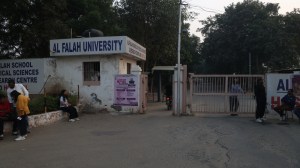Delhi HC blast accused is freelancer,used ATM to throw cops off: probe
Wasims interrogation revealed that those events deeply influenced him too.
Six weeks into the Delhi High Court blast probe,investigators are zeroing in on the conclusion that the attack was not the handiwork of one particular terror group but a freelance enterprise of prime accused Wasim Akram Malik who,they allege,scouted and arranged for resources from militant contacts in the Kishtwar region of Jammu and Kashmir.
While this construct has come in for sharp questioning within the security establishment,the National Investigation Agency is learnt to have conveyed that the evidence so far points to syndication among terror groups operating in India because of which Wasim had contacts in more than one outfit.
Parallels are being drawn with the failed Times Square bomber Faisal Shehzad,who plotted the attack on his own initiative though he did receive training in Pak-based terror camps including that of the Lashkar-e-Toiba.
The 2008 Amarnath Yatra clashes are the common thread which has emerged in the interrogation so far. In fact,information available on Amir Ali Kamal,whose photograph the NIA released yesterday as an accomplice in the blast,is that he turned radical soon after the 2008 clashes.
Wasims interrogation revealed that those events deeply influenced him too. Events related to those clashes were effectively used to motivate Wasims younger brother Junaid and Amir Abbas,the one who allegedly passed on the contents of the email to the 16-year-old who was allegedly lured to send the email which claimed that Harkat-ul-Jihad Islami carried out the attack.
Investigators are now certain that the email was prepared at least two days before the September 7 blast. While they have statements to this effect,sources said,theres also corroborative technical evidence to back this. This is what was seen as the promising lead as the probe focused on Kishtwar.
Wasims interrogation is,however,said to have provided the definitive turning point. He has allegedly underlined his personal admiration for Afzal Guru,which dates back to his connection with the Jaish-e-Mohammed. In 2005,he was found traveling in the same vehicle as Jaish-e-Mohammed commander Saleem Wani.
While Wani was arrested,Wasim was detained and then released as he was then a student who claimed to be returning from tuition.
But now investigations have show that his presence in the vehicle was no coincidence and even after Wanis arrest,he remained in close touch with the Jaish commanders Pakistani bodyguard Hassan who was later killed in 2009.
One of the lessons Wasim claims to have learnt after the 2005 incident (Wanis arrest) was that the mobile phone was a dead giveaway. Wanis associates had told Wasim that the vehicles whereabouts were tracked by tracing the mobile phone location.
In 2011,investigators believe Wasim tried to hoodwink sleuths by being in a Jammu mall on the day of the blasts,knowing well that his mobile phone records would be looked into. He operated an ATM,sources said,at 1.45 pm – about 35 minutes after the mail was sent on September 7 but did not conduct any transaction. It now turns out that he wanted a record of his photograph with the ATM camera.
Investigators suspect that Wasim is the one who came up with the plan and used his contacts within the Hizbul Mujahideen cadre to get ammunition for creating an IED. Kamaal was his main contact while brother Junaid assisted in ensuring the transfer of explosives to Delhi. The two Bangladeshis,who Wasim brought along with him in August last week,were members of the Islamic Chhatra Shibir and suspected to have carried out the blasts.
Incidentally,Wasim has expressed regret at brother Junaid also taking to militancy and claims that he had no role in it. Junaid himself was on the run after the party which was taking him across the LoC for training came under military fire. Since then,he is said to be operating in Dachchan near Kishtwar. There are reports that he even tried to send messages of surrender at last year but it did not materialise.
Over the past six months,sources said,there has been an increase in the number of IED blasts in the Jammu-Poonch area. One such incident on May 2,near Udhampur,was attributed to LeT in which a remote IED was set off,aimed at killing an Army General officer but did not achieve the target. Several recoveries have also been made between April and June,which investigators believe show the presence of explosives.
The bomb that went off at Delhi High Court was also set off by a remote trigger. Interestingly,investigators believe that the first Delhi High Court blast was,perhaps,not carried out by the same module. That angle is still under investigation.



- 01
- 02
- 03
- 04
- 05




























